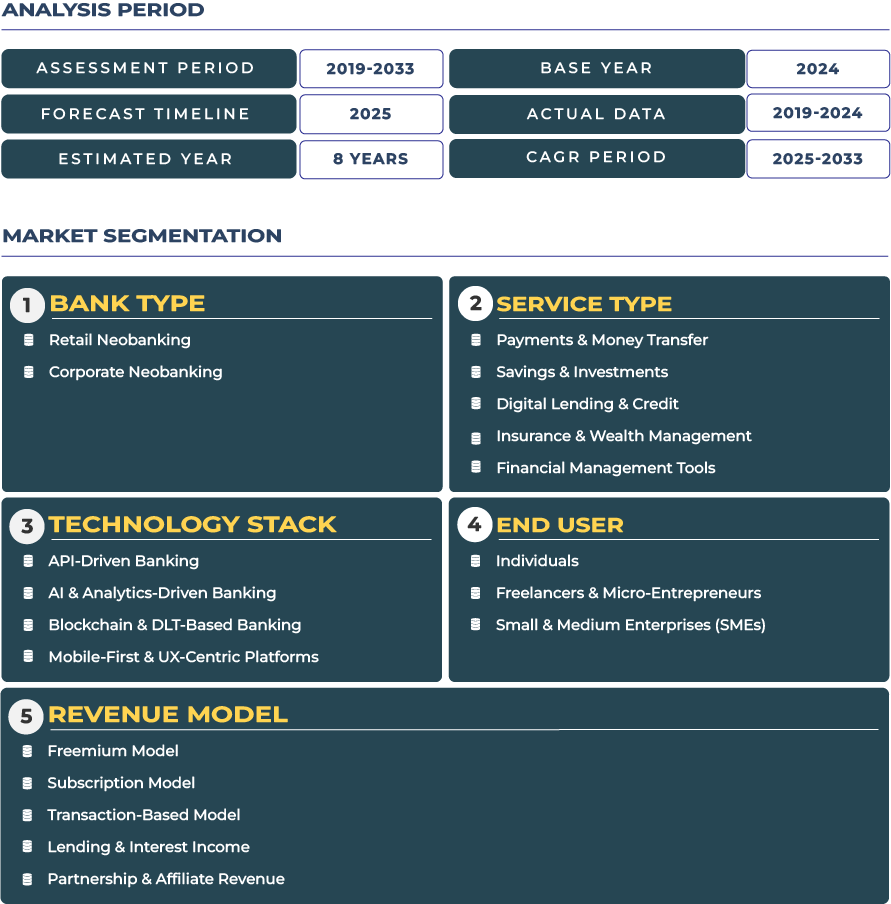Grassroots Wallet Inclusion, QR Penetration, and SME FX Resilience Accelerate Peru Fintech Neobanking Evolution
Peru digital finance trajectory is distinguished by grassroots wallet adoption, QR payment normalization, and rising treasury automation among micro-enterprises and exporters. Digital-banking technology vendors supplying modular onboarding, micro-wallet orchestration, and offline-transaction engines are scaling across urban and rural corridors, driven by national wallet brands and mobile-centric consumer behavior. The Peru fintech neobanking market is projected to reach USD 377.7 Billion by 2033, expanding at a CAGR of 24.7% as wallet ecosystems transition from peer-to-peer payments to savings pockets, loyalty triggers, and SME settlement logic. Government digital inclusion and e-transaction alignment initiatives from Government of Peru and digital payment expansion under Superintendencia de Banca, Seguros y AFP support secure identity layers and risk-compliant wallet activation across Lima, Arequipa, and Trujillo. Platform providers embed QR-to-wallet rails, cash-to-digital conversion flows, and micro-credit tagging for gig workers and provincial merchants. Vendors such as Yape expand agent-assisted onboarding, family wallet modules, and micro-merchant settlement workflows, reinforcing a shift toward digitally governed payment and budgeting patterns. As rural commerce digitizes, exporters and SMEs increasingly adopt simplified FX pocketing and hedging controls, while offline QR and message-based confirmation rails support transactional continuity in low-bandwidth regions. Despite policy shifts, inflation cycles, and uneven connectivity, modular wallet engines, compliance telemetry, and credit-scoring innovation continue to shape Peru fintech neobanking ecosystem, balancing mass-market inclusion with enterprise treasury modernization.
Yape-Led Wallet Adoption, Export-FX Momentum, and Rural QR Expansion Define Peru Fintech Neobanking Path
Growth Drivers: Yape-Plin Penetration, Export FX Flows, and Low-Friction Wallet UX
Peru fintech ecosystem benefits from national-scale wallet familiarity, QR ubiquity, and telecommunication-enabled onboarding across diverse demographics. Yape and Plin adoption across urban transport, informal retail corridors, and gig-work platforms accelerates micro-merchant digital behavior and recurring wallet use. Export-focused SMEs adopt cross-border settlement pockets, FX conversion timing controls, and automated reconciliation, especially across Lima logistics hubs and coastal agricultural exporters. Government digital-payment promotion strengthens verified identity and digital signature participation, improving trust in instant transfer rails and platform-based financial routines.
Restraints: Informality Density and Rural Connectivity Gaps
Informal cash cycles and fragmented income trails slow automated credit scoring, requiring vendors to integrate merchant cashback wallets, hybrid KYC tiers, and SMS-layer confirmations. Rural connectivity inconsistencies demand offline workflows, sync-later ledgers, and USSD-supported wallet activation. Regulatory evolution around data governance and fraud containment requires zero-trust identity rules and device-risk scoring as volumes rise.
Trends: QR Provincial Builds and SME FX Hedge Adoption
Provincial QR infrastructure deepens wallet habit formation beyond Lima, driven by local commerce hubs in Chiclayo, Piura, and Cusco. SMEs adopt lightweight FX hedging and cross-border routing layers to stabilize cash cycles amid commodity trade exposure. Platform vendors deploy automated tax pockets, spend categorization, and payout scheduling aligned with supplier tiers and seasonal cycles.
Opportunities: Agent QR Rollout and Micro-Hedging Platforms
Expansion of agent QR stations and kiosk-based onboarding supports low-connectivity districts and cash-first micro-retailers. Micro-hedging rails enabling stable-value transitions and invoice-timing optimization unlock treasury resilience for export-driven SMEs and freelancers. Telco partnerships strengthen distribution, authentication, and payment confirmation in disconnected zones, reinforcing digital identity inclusion and usage continuity.
Competitive Landscape: Telco Distribution, FX Control Modules, and Merchant Workflow APIs
Fintech platform vendors scale via telco distribution, cooperative networks, and marketplace alliances. In 2024, Yape advanced merchant settlement rails and community wallet extensions, supporting hybrid onboarding and digital-first commerce enablement. Vendors integrate FX forward-style logic for small exporters, multi-wallet segmentation for family accounts, and anomaly detection for QR-based fraud defense. Frameworks align with SBS Peru guidance, enabling secure multi-entity wallet orchestration, real-time consent layers, and offline merchant acceptance across Lima, La Libertad, and Junín corridors.







